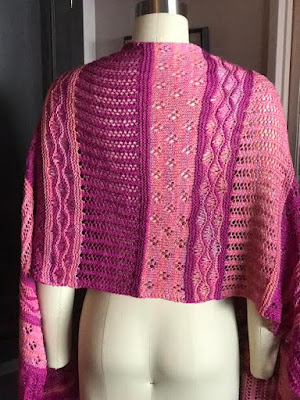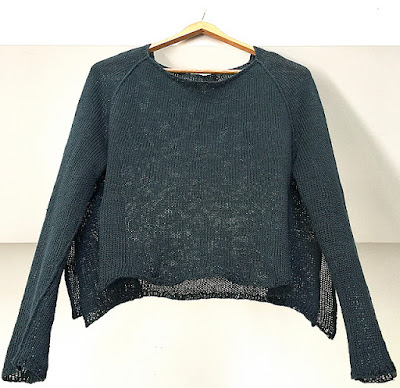 |
| http://www.ravelry.com/patterns/library/antonine |
Once a week I post interviews with interesting people about their insights on their experience of working in the Knitting industry. I’ve noticed that every one of these individuals makes their living in a slightly different manner bringing their own unique presence to the knitting world.
You can find Valerie here and here on Ravelry.
 |
| http://www.ravelry.com/patterns/library/cape-battersea |
Where do you find inspiration?
Most of
the time I’m inspired by the yarn. I'm a purchase-first-plan-later kind
of knitter. When I feel ready to start the design process, I dive into
the stash and a yarn usually jumps out at me. I then design around that
yarn, considering its texture, color or color pattern, and drape. Other
times a design idea will pop into my head while doing mundane tasks...
dish-washing and daily commuting really get me daydreaming! For this I
keep my day planner handy to jot things down before the idea floats
away. I keep knitting graph paper in there just case!
 |
| http://www.ravelry.com/patterns/library/battersea-2 |
What is your favourite knitting technique?
I
love most techniques (even plain stockinette and fussy seaming!), so
I'm going to have to flip that question around and say that my least
favorite knitting techniques are complex, evolving cables that require
me to keep notes, and intarsia. I love the end results, but those are
the techniques that slow me down the most… and I'm a slow knitter to
begin with!
 |
| http://www.ravelry.com/patterns/library/northumberland-2 |
Do you look at other designers’ work or are you afraid that you will be influenced by their designs?
Honestly,
I feel it's nearly impossible not to be influenced by other designers. I
don't think you can completely isolate yourself from other creatives
and still expect to feel challenged and inspired. I’ve often thought
that musicians must have a similar dilemma, with musical scores being
composed of a limited number of defined key components. Countless have
come before, combining those elements in what seems like every which way
possible, and yet beautiful, original works are released every day!
Before
throwing myself entirely into a design I'll spend at least an hour
scouring Ravelry to make sure I haven't subconsciously or
serendipitously repeated an existing design. I'd like to think other
designers do the same!
 |
| http://www.ravelry.com/patterns/library/northumberland-2 |
How many sample/test knitters do you have working for you or do you do it all yourself?
I
try to do the test-knitting myself by making 2 samples of each design. I
don't feel comfortable asking knitters to test-knit for me for free and
since I pay a professional tech editor for her hard work, hiring test
knitters without the certainty that I’ll sell enough patterns to break
even is too costly a gamble for me right now.I did have four
wonderful volunteer test-knitters for Glenvalley. I was and still am
just blown away by that kind of generosity, because I really feel like
test-knitters should be compensated. So until I reach a level where I
know for certain I can pay both test-knitters and my editor, I'll
probably continue to do the test-knitting myself.
Did you do a formal business plan?
I
consider my dabbling in design more of a hobby. My most popular
patterns are free and I like to encourage people to donate to local food
banks and shelters in exchange. If I manage to sell enough copies of a
pattern to cover the cost of the yarn, editor, and a portion of my photo
editing software subscription, then I'm golden! My day job isn't in a
creative field so I really appreciate the creative outlet designing
affords me. I'm not aiming for it to become my principal source of
income.
 |
| http://www.ravelry.com/patterns/library/old-salt-8 |
How do you maintain your life/work balance?
By letting housework fall by the wayside ;)
I
have a ridiculously long work commute and that's when I do the majority
of my knitting. I don't get home in the evening until about 7 and then
it's a dance of cooking, dish-washing and lunch prep. Usually the
photography has to wait until the weekend. Since I both model and
photograph the designs, I have to use a self-timer and really take my
time. Every time I rush things I regret it later!
How do you deal with criticism?
If
the criticism relates to the fit, accuracy or clarity of my patterns,
I'm rather grateful it! I recently pulled one of the first patterns I
designed because some Ravelers were disappointed with the fit. A design
might be free but what use is it when it doesn’t fit well?
 |
| http://www.ravelry.com/patterns/library/rafaelle |
How long did it take for you to be able to support yourself?
I
don’t expect to ever be able to support myself from designing. A more
realistic goal for me would be for the hobby to support itself. That
would be amazing.
What’s next for you?
Since
I’ve just recently published my Northumberland shawl pattern, I’m
resting my brain a little bit and just enjoying knitting some plain
vanilla socks. But a few days ago I came across some beautiful skeins of
Viola yarn in the stash and put them aside for a lightweight cardigan
design. Turning an idea into a tangible garment is addictive!
 |
| http://www.ravelry.com/patterns/library/leta |

















































